Abstract
3'-Fluoro-3'-deoxythymidine (FLT), a candidate anti-AIDS compound in clinical trials, showed anti-human immunodeficiency virus type 1 (HIV-1) potency (50% effective concentration, 0.0052 microM) slightly better than or equal to that of 3'-azido-3'-deoxythymidine (AZT) in MT4 cells and was threefold more potent in H9 cells. There was no FLT resistance demonstrable in the AZT-resistant HIV-1 strains. Both FLT and AZT showed low cytotoxicity for MT4 cells, with selectivity indices (efficacy/toxicity ratio) of greater than 47,000 and greater than 33,000, respectively. Cellular permeation of FLT and thymidine (dThd) was greater than that of AZT, and FLT and dThd permeated the cell membranes by a carrier-mediated mechanism as well as by simple diffusion, as indicated by the existence of nitrobenzylthioinosine-5'-monophosphate-sensitive and -insensitive components. By contrast, transport of AZT into cells was by simple diffusion. The intracellular level of the triphosphate of FLT (FLTTP) in MT4 cells was two- to threefold higher than that of AZT (AZTTP) after exposure to 1.8 microM each compound for 12 h. The elimination kinetics of FLTTP and AZTTP in HIV-1-infected MT4 cells in fresh medium showed biphasic patterns, with initial half-lives of 1.03 and 1.09 h, respectively. In phytohemagglutinin-stimulated human peripheral blood lymphocytes, the FLTTP level was increased 59-fold compared with that in unstimulated cells at 12 h, was four- to sixfold higher than the level of AZTTP in stimulated cells at 12 h, and remained four- to fivefold higher during a 4-h elimination period in fresh medium and twofold higher at the end of a 12-h elimination period. Two- to eightfold more [3H]AZT than [3H]FLT was incorporated into the host cell DNA, and both [3H]AZT and [3H]FLT remained persistently incorporated for over 24 h. The incorporated [3H]AZT and [3H]FLT were alkali labile, whereas incorporated [3H]dThd was alkali stable. Pharmacokinetics of FLT in plasma of monkeys after intravenous (i.v.) administration showed that the FLT concentration in plasma declined, with a half-life of 1.19 +/- 0.1 h; the steady-state volume of distribution was 0.93 +/- 0.2 liter/kg of body weight, and total clearance was 0.56 +/- 0.15 liter/kg. Oral bioavailability of FLT was excellent and comparable to i.v. bioavailability in terms of areas under the concentration-time curves for three monkeys. Of the total dose, 41 to 61% was excreted in urine as unchanged FLT, and only 3.2 to 7.4% of the total dose was identified as glucuronide-conjugated FLT in urine 48 h after i.v. administration to monkeys. We conclude that FLT exhibits an anti-HIV-1 potency similar to that of AZT but with slightly better selectivity of effects and with higher intracellular active metabolite levels.
Full text
PDF
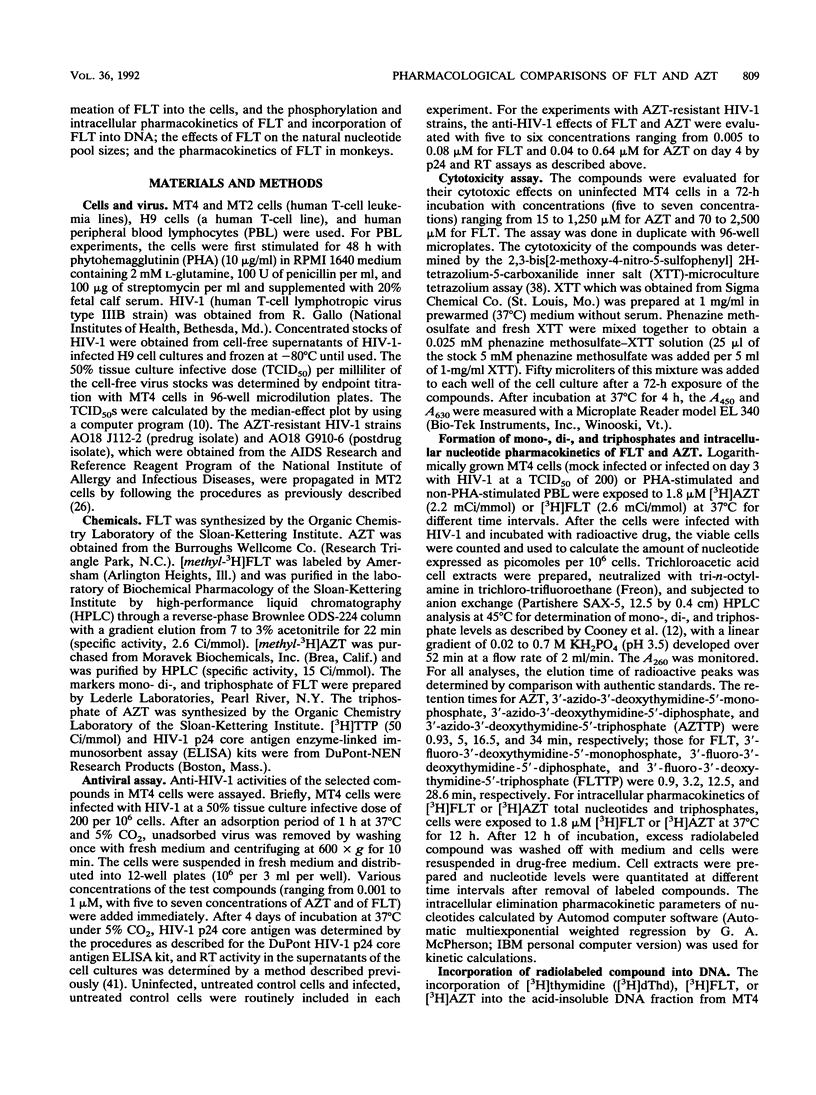


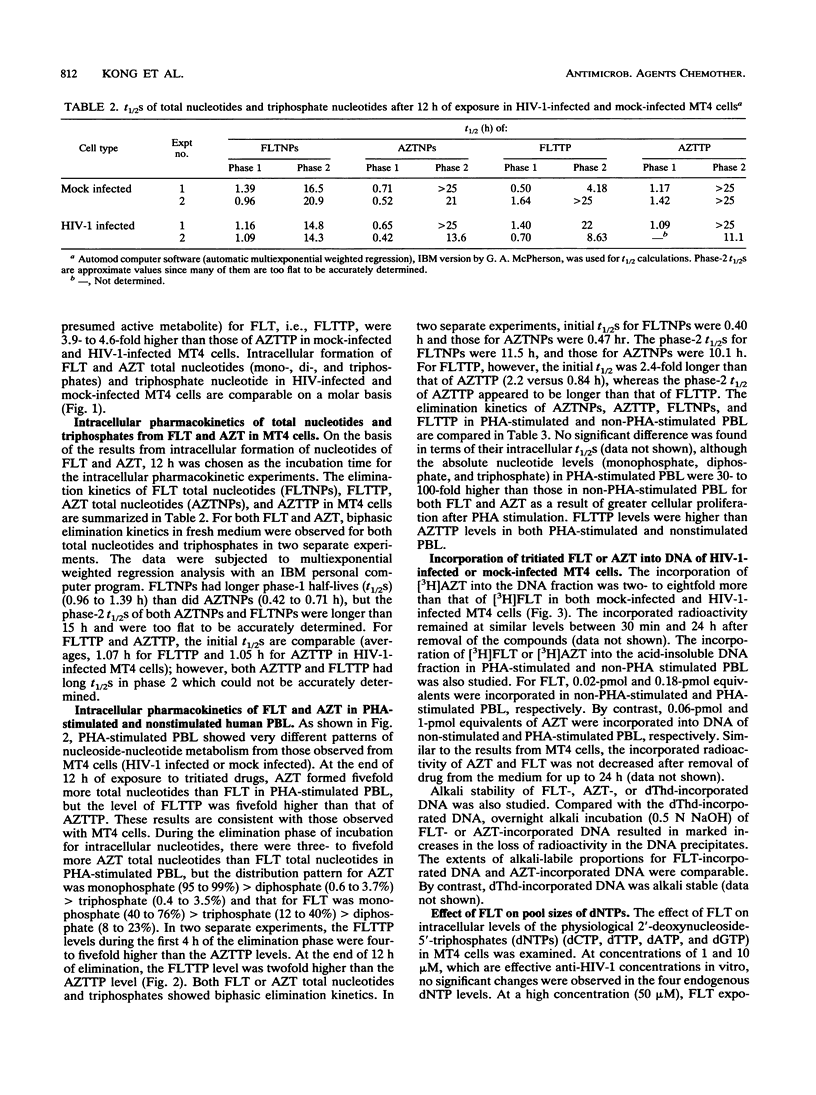

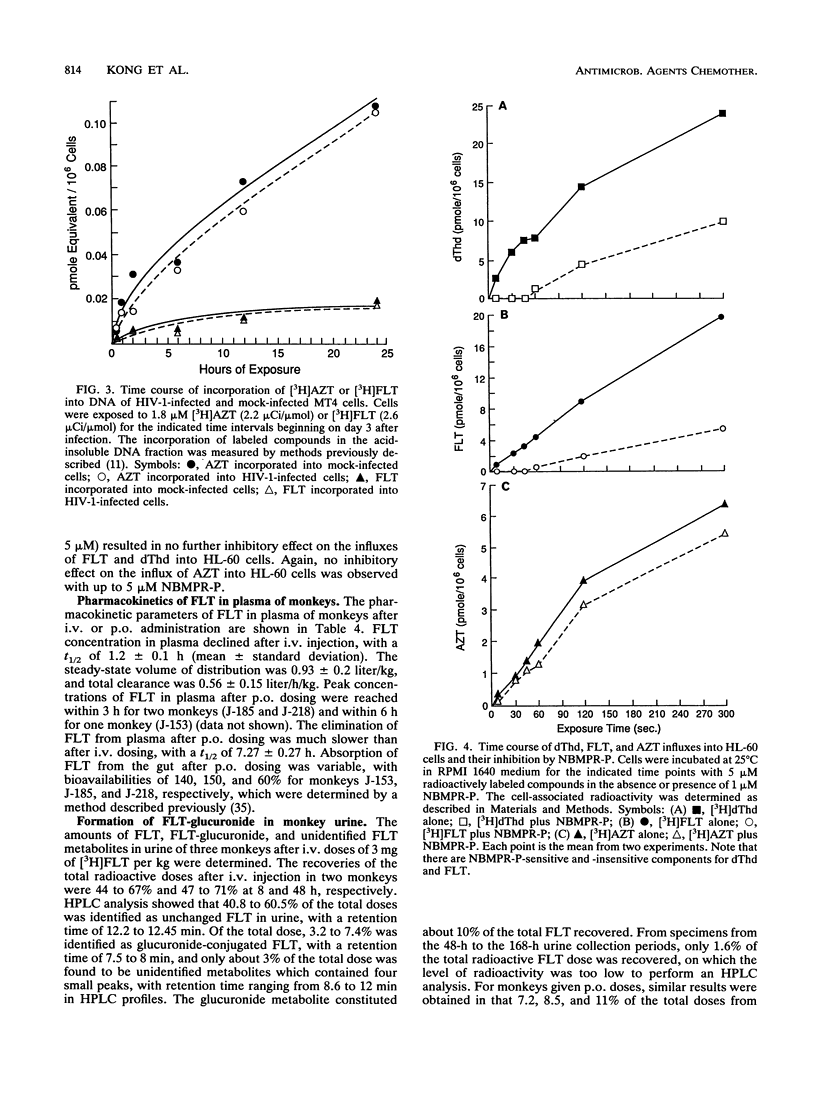
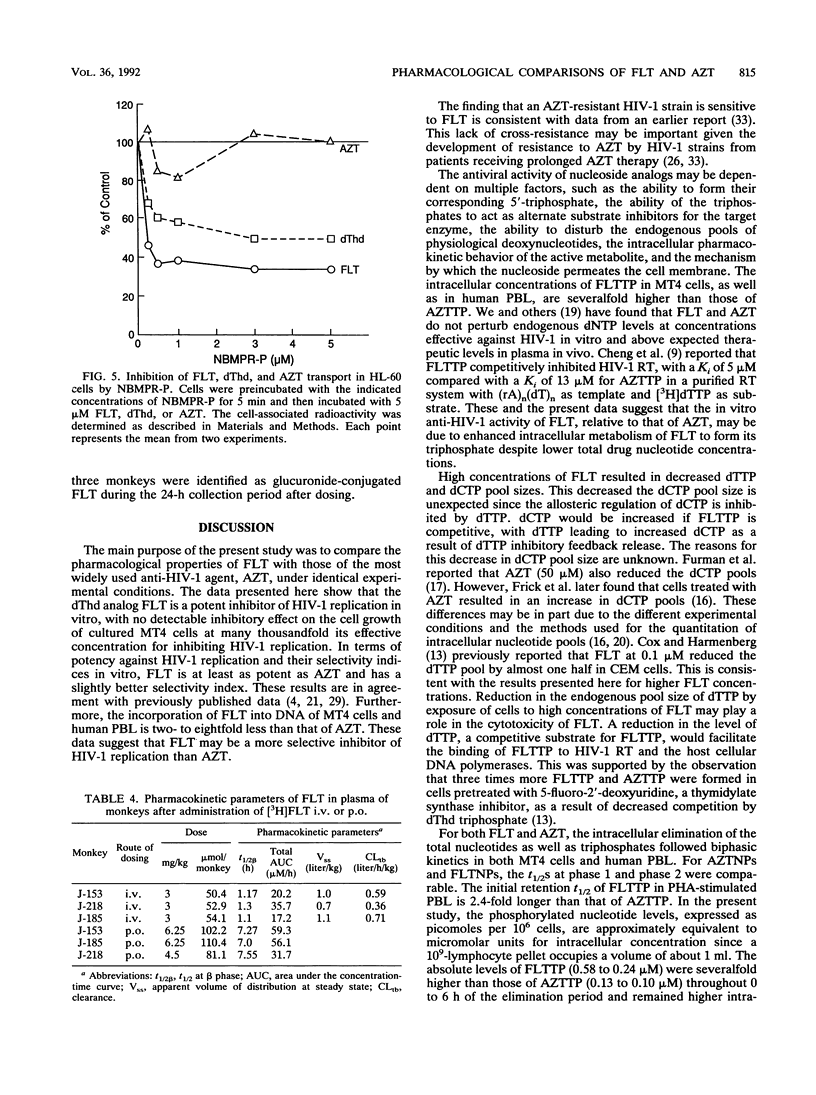


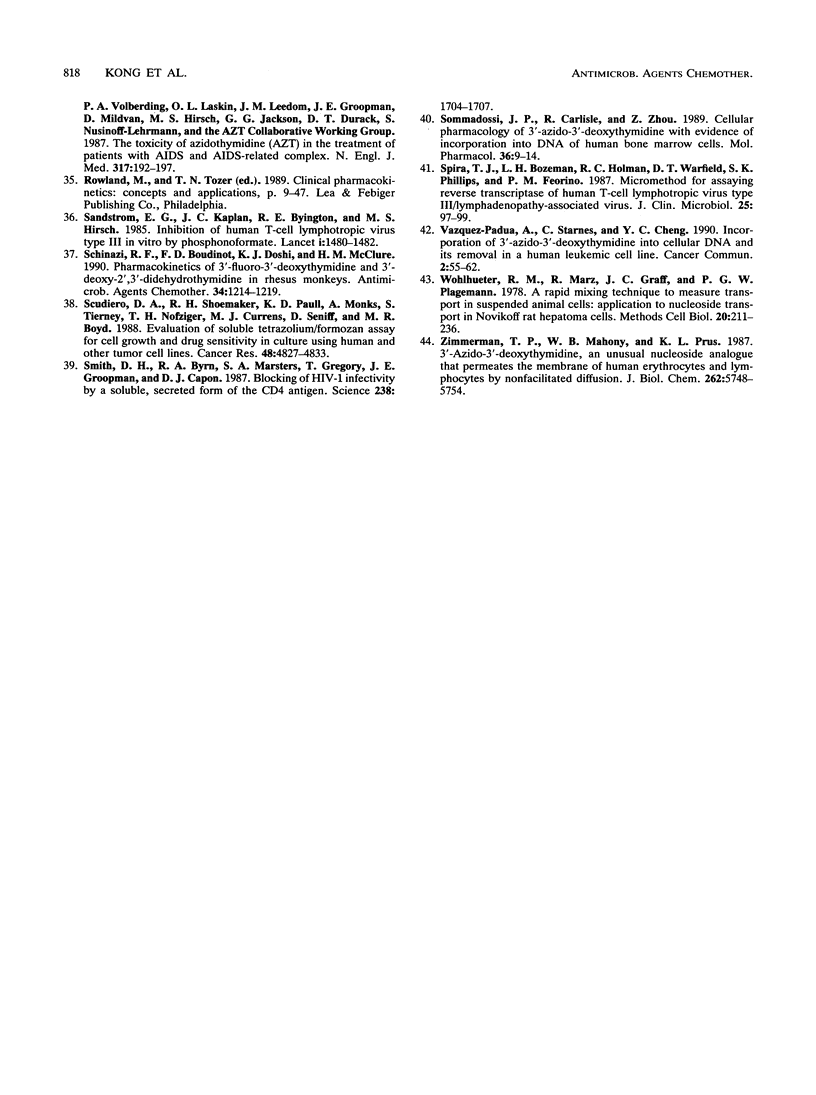
Selected References
These references are in PubMed. This may not be the complete list of references from this article.
- Balzarini J., Baba M., Pauwels R., Herdewijn P., De Clerq E. Anti-retrovirus activity of 3'-fluoro- and 3'-azido-substituted pyrimidine 2',3'-dideoxynucleoside analogues. Biochem Pharmacol. 1988 Jul 15;37(14):2847–2856. doi: 10.1016/0006-2952(88)90049-4. [DOI] [PubMed] [Google Scholar]
- Balzarini J., Pauwels R., Baba M., Herdewijn P., de Clercq E., Broder S., Johns D. G. The in vitro and in vivo anti-retrovirus activity, and intracellular metabolism of 3'-azido-2',3'-dideoxythymidine and 2',3'-dideoxycytidine are highly dependent on the cell species. Biochem Pharmacol. 1988 Mar 1;37(5):897–903. doi: 10.1016/0006-2952(88)90178-5. [DOI] [PubMed] [Google Scholar]
- Barré-Sinoussi F., Chermann J. C., Rey F., Nugeyre M. T., Chamaret S., Gruest J., Dauguet C., Axler-Blin C., Vézinet-Brun F., Rouzioux C. Isolation of a T-lymphotropic retrovirus from a patient at risk for acquired immune deficiency syndrome (AIDS). Science. 1983 May 20;220(4599):868–871. doi: 10.1126/science.6189183. [DOI] [PubMed] [Google Scholar]
- Bazin H., Chattopadhyaya J., Datema R., Ericson A. C., Gilljam G., Johansson N. G., Hansen J., Koshida R., Moelling K., Oberg B. An analysis of the inhibition of replication of HIV and MuLV by some 3'-blocked pyrimidine analogs. Biochem Pharmacol. 1989 Jan 1;38(1):109–119. doi: 10.1016/0006-2952(89)90157-3. [DOI] [PubMed] [Google Scholar]
- Blum M. R., Liao S. H., Good S. S., de Miranda P. Pharmacokinetics and bioavailability of zidovudine in humans. Am J Med. 1988 Aug 29;85(2A):189–194. [PubMed] [Google Scholar]
- Boudinot F. D., Schinazi R. F., Gallo J. M., McClure H. M., Anderson D. C., Doshi K. J., Kambhampathi P. C., Chu C. K. 3'-Azido-2',3'-dideoxyuridine (AzddU): comparative pharmacokinetics with 3'-azido-3'-deoxythymidine (AZT) in monkeys. AIDS Res Hum Retroviruses. 1990 Feb;6(2):219–228. doi: 10.1089/aid.1990.6.219. [DOI] [PubMed] [Google Scholar]
- Boudinot F. D., Smith S. G., Funderburg E. D., Schinazi R. F. Pharmacokinetics of 3'-fluoro-3'-deoxythymidine and 3'-deoxy-2',3'-didehydrothymidine in rats. Antimicrob Agents Chemother. 1991 Apr;35(4):747–749. doi: 10.1128/aac.35.4.747. [DOI] [PMC free article] [PubMed] [Google Scholar]
- Broder S., Gallo R. C. A pathogenic retrovirus (HTLV-III) linked to AIDS. N Engl J Med. 1984 Nov 15;311(20):1292–1297. doi: 10.1056/NEJM198411153112006. [DOI] [PubMed] [Google Scholar]
- Cheng Y. C., Dutschman G. E., Bastow K. F., Sarngadharan M. G., Ting R. Y. Human immunodeficiency virus reverse transcriptase. General properties and its interactions with nucleoside triphosphate analogs. J Biol Chem. 1987 Feb 15;262(5):2187–2189. [PubMed] [Google Scholar]
- Chou T. C., Schmid F. A., Feinberg A., Philips F. S., Han J. Uptake, initial effects, and chemotherapeutic efficacy of harringtonine in murine leukemic cells sensitive and resistant to vincristine and other chemotherapeutic agents. Cancer Res. 1983 Jul;43(7):3074–3079. [PubMed] [Google Scholar]
- Cooney D. A., Dalal M., Mitsuya H., McMahon J. B., Nadkarni M., Balzarini J., Broder S., Johns D. G. Initial studies on the cellular pharmacology of 2',3-dideoxycytidine, an inhibitor of HTLV-III infectivity. Biochem Pharmacol. 1986 Jul 1;35(13):2065–2068. doi: 10.1016/0006-2952(86)90571-x. [DOI] [PubMed] [Google Scholar]
- Feinberg A., Leyland-Jones B., Fanucchi M. P., Hancock C., Fox J. J., Watanabe K. A., Vidal P. M., Williams L., Young C. W., Philips F. S. Biotransformation and elimination of [2-14C]-1-(2-deoxy-2'-fluoro-beta-D -arabinofuranosyl)-5-iodocytosine in immunosuppressed patients with herpesvirus infections. Antimicrob Agents Chemother. 1985 May;27(5):733–738. doi: 10.1128/aac.27.5.733. [DOI] [PMC free article] [PubMed] [Google Scholar]
- Fischl M. A., Richman D. D., Grieco M. H., Gottlieb M. S., Volberding P. A., Laskin O. L., Leedom J. M., Groopman J. E., Mildvan D., Schooley R. T. The efficacy of azidothymidine (AZT) in the treatment of patients with AIDS and AIDS-related complex. A double-blind, placebo-controlled trial. N Engl J Med. 1987 Jul 23;317(4):185–191. doi: 10.1056/NEJM198707233170401. [DOI] [PubMed] [Google Scholar]
- Frick L. W., Nelson D. J., St Clair M. H., Furman P. A., Krenitsky T. A. Effects of 3'-azido-3'-deoxythymidine on the deoxynucleotide triphosphate pools of cultured human cells. Biochem Biophys Res Commun. 1988 Jul 15;154(1):124–129. doi: 10.1016/0006-291x(88)90659-6. [DOI] [PubMed] [Google Scholar]
- Furman P. A., Fyfe J. A., St Clair M. H., Weinhold K., Rideout J. L., Freeman G. A., Lehrman S. N., Bolognesi D. P., Broder S., Mitsuya H. Phosphorylation of 3'-azido-3'-deoxythymidine and selective interaction of the 5'-triphosphate with human immunodeficiency virus reverse transcriptase. Proc Natl Acad Sci U S A. 1986 Nov;83(21):8333–8337. doi: 10.1073/pnas.83.21.8333. [DOI] [PMC free article] [PubMed] [Google Scholar]
- Garrett C., Santi D. V. A rapid and sensitive high pressure liquid chromatography assay for deoxyribonucleoside triphosphates in cell extracts. Anal Biochem. 1979 Nov 1;99(2):268–273. doi: 10.1016/s0003-2697(79)80005-6. [DOI] [PubMed] [Google Scholar]
- Hao Z., Cooney D. A., Hartman N. R., Perno C. F., Fridland A., DeVico A. L., Sarngadharan M. G., Broder S., Johns D. G. Factors determining the activity of 2',3'-dideoxynucleosides in suppressing human immunodeficiency virus in vitro. Mol Pharmacol. 1988 Oct;34(4):431–435. [PubMed] [Google Scholar]
- Harmenberg J., Cox S., Akesson-Johansson A. Improved sample preparation method for high-performance liquid chromatography of deoxyribonucleoside triphosphates from cell culture extracts. J Chromatogr. 1990 May 25;508(1):75–79. doi: 10.1016/s0021-9673(00)91241-x. [DOI] [PubMed] [Google Scholar]
- Hartmann H., Vogt M. W., Durno A. G., Hirsch M. S., Hunsmann G., Eckstein F. Enhanced in vitro inhibition of HIV-1 replication by 3'-fluoro-3'-deoxythymidine compared to several other nucleoside analogs. AIDS Res Hum Retroviruses. 1988 Dec;4(6):457–466. doi: 10.1089/aid.1988.4.457. [DOI] [PubMed] [Google Scholar]
- Herdewijn P., Balzarini J., De Clercq E., Pauwels R., Baba M., Broder S., Vanderhaeghe H. 3'-substituted 2',3'-dideoxynucleoside analogues as potential anti-HIV (HTLV-III/LAV) agents. J Med Chem. 1987 Aug;30(8):1270–1278. doi: 10.1021/jm00391a003. [DOI] [PubMed] [Google Scholar]
- Hirsch M. S. Chemotherapy of human immunodeficiency virus infections: current practice and future prospects. J Infect Dis. 1990 May;161(5):845–857. doi: 10.1093/infdis/161.5.845. [DOI] [PubMed] [Google Scholar]
- Ho H. T., Hitchcock M. J. Cellular pharmacology of 2',3'-dideoxy-2',3'-didehydrothymidine, a nucleoside analog active against human immunodeficiency virus. Antimicrob Agents Chemother. 1989 Jun;33(6):844–849. doi: 10.1128/aac.33.6.844. [DOI] [PMC free article] [PubMed] [Google Scholar]
- Huang J. T., Chen L. C., Wang L. B., Kim M. H., Warshaw J. A., Armstrong D., Zhu Q. Y., Chou T. C., Watanabe K. A., Matulic-Adamic J. Fluorinated sugar analogues of potential anti-HIV-1 nucleosides. J Med Chem. 1991 May;34(5):1640–1646. doi: 10.1021/jm00109a017. [DOI] [PubMed] [Google Scholar]
- Larder B. A., Darby G., Richman D. D. HIV with reduced sensitivity to zidovudine (AZT) isolated during prolonged therapy. Science. 1989 Mar 31;243(4899):1731–1734. doi: 10.1126/science.2467383. [DOI] [PubMed] [Google Scholar]
- Matthes E., Lehmann C., Scholz D., Rosenthal H. A., Langen P. Phosphorylation, anti-HIV activity and cytotoxicity of 3'-fluorothymidine. Biochem Biophys Res Commun. 1988 Jun 16;153(2):825–831. doi: 10.1016/s0006-291x(88)81170-7. [DOI] [PubMed] [Google Scholar]
- Matthes E., Lehmann C., Scholz D., von Janta-Lipinski M., Gaertner K., Rosenthal H. A., Langen P. Inhibition of HIV-associated reverse transcriptase by sugar-modified derivatives of thymidine 5'-triphosphate in comparison to cellular DNA polymerases alpha and beta. Biochem Biophys Res Commun. 1987 Oct 14;148(1):78–85. doi: 10.1016/0006-291x(87)91078-3. [DOI] [PubMed] [Google Scholar]
- Matthes E., Lehmann C., von Janta-Lipinski M., Scholz D. Inhibition of HIV-replication by 3'-fluoro-modified nucleosides with low cytotoxicity. Biochem Biophys Res Commun. 1989 Nov 30;165(1):488–495. doi: 10.1016/0006-291x(89)91096-6. [DOI] [PubMed] [Google Scholar]
- Mitsuya H., Broder S. Inhibition of the in vitro infectivity and cytopathic effect of human T-lymphotrophic virus type III/lymphadenopathy-associated virus (HTLV-III/LAV) by 2',3'-dideoxynucleosides. Proc Natl Acad Sci U S A. 1986 Mar;83(6):1911–1915. doi: 10.1073/pnas.83.6.1911. [DOI] [PMC free article] [PubMed] [Google Scholar]
- Mitsuya H., Looney D. J., Kuno S., Ueno R., Wong-Staal F., Broder S. Dextran sulfate suppression of viruses in the HIV family: inhibition of virion binding to CD4+ cells. Science. 1988 Apr 29;240(4852):646–649. doi: 10.1126/science.2452480. [DOI] [PubMed] [Google Scholar]
- Mitsuya H., Weinhold K. J., Furman P. A., St Clair M. H., Lehrman S. N., Gallo R. C., Bolognesi D., Barry D. W., Broder S. 3'-Azido-3'-deoxythymidine (BW A509U): an antiviral agent that inhibits the infectivity and cytopathic effect of human T-lymphotropic virus type III/lymphadenopathy-associated virus in vitro. Proc Natl Acad Sci U S A. 1985 Oct;82(20):7096–7100. doi: 10.1073/pnas.82.20.7096. [DOI] [PMC free article] [PubMed] [Google Scholar]
- Richman D. D., Fischl M. A., Grieco M. H., Gottlieb M. S., Volberding P. A., Laskin O. L., Leedom J. M., Groopman J. E., Mildvan D., Hirsch M. S. The toxicity of azidothymidine (AZT) in the treatment of patients with AIDS and AIDS-related complex. A double-blind, placebo-controlled trial. N Engl J Med. 1987 Jul 23;317(4):192–197. doi: 10.1056/NEJM198707233170402. [DOI] [PubMed] [Google Scholar]
- Richman D. D. Susceptibility to nucleoside analogues of zidovudine-resistant isolates of human immunodeficiency virus. Am J Med. 1990 May 21;88(5B):8S–10S. doi: 10.1016/0002-9343(90)90414-9. [DOI] [PubMed] [Google Scholar]
- Sandstrom E. G., Kaplan J. C., Byington R. E., Hirsch M. S. Inhibition of human T-cell lymphotropic virus type III in vitro by phosphonoformate. Lancet. 1985 Jun 29;1(8444):1480–1482. doi: 10.1016/s0140-6736(85)92255-x. [DOI] [PubMed] [Google Scholar]
- Schinazi R. F., Boudinot F. D., Doshi K. J., McClure H. M. Pharmacokinetics of 3'-fluoro-3'-deoxythymidine and 3'-deoxy-2',3'-didehydrothymidine in rhesus monkeys. Antimicrob Agents Chemother. 1990 Jun;34(6):1214–1219. doi: 10.1128/aac.34.6.1214. [DOI] [PMC free article] [PubMed] [Google Scholar]
- Scudiero D. A., Shoemaker R. H., Paull K. D., Monks A., Tierney S., Nofziger T. H., Currens M. J., Seniff D., Boyd M. R. Evaluation of a soluble tetrazolium/formazan assay for cell growth and drug sensitivity in culture using human and other tumor cell lines. Cancer Res. 1988 Sep 1;48(17):4827–4833. [PubMed] [Google Scholar]
- Smith D. H., Byrn R. A., Marsters S. A., Gregory T., Groopman J. E., Capon D. J. Blocking of HIV-1 infectivity by a soluble, secreted form of the CD4 antigen. Science. 1987 Dec 18;238(4834):1704–1707. doi: 10.1126/science.3500514. [DOI] [PubMed] [Google Scholar]
- Sommadossi J. P., Carlisle R., Zhou Z. Cellular pharmacology of 3'-azido-3'-deoxythymidine with evidence of incorporation into DNA of human bone marrow cells. Mol Pharmacol. 1989 Jul;36(1):9–14. [PubMed] [Google Scholar]
- Spira T. J., Bozeman L. H., Holman R. C., Warfield D. T., Phillips S. K., Feorino P. M. Micromethod for assaying reverse transcriptase of human T-cell lymphotropic virus type III/lymphadenopathy-associated virus. J Clin Microbiol. 1987 Jan;25(1):97–99. doi: 10.1128/jcm.25.1.97-99.1987. [DOI] [PMC free article] [PubMed] [Google Scholar]
- Vazquez-Padua M. A., Starnes M. C., Cheng Y. C. Incorporation of 3'-azido-3'-deoxythymidine into cellular DNA and its removal in a human leukemic cell line. Cancer Commun. 1990;2(1):55–62. doi: 10.3727/095535490820874740. [DOI] [PubMed] [Google Scholar]
- Wohlhueter R. M., Marz R., Graff J. C., Plagemann P. G. A rapid-mixing technique to measure transport in suspended animal cells: applications to nucleoside transport in Novikoff rat hepatoma cells. Methods Cell Biol. 1978;20:211–236. doi: 10.1016/s0091-679x(08)62020-8. [DOI] [PubMed] [Google Scholar]
- Zimmerman T. P., Mahony W. B., Prus K. L. 3'-azido-3'-deoxythymidine. An unusual nucleoside analogue that permeates the membrane of human erythrocytes and lymphocytes by nonfacilitated diffusion. J Biol Chem. 1987 Apr 25;262(12):5748–5754. [PubMed] [Google Scholar]


